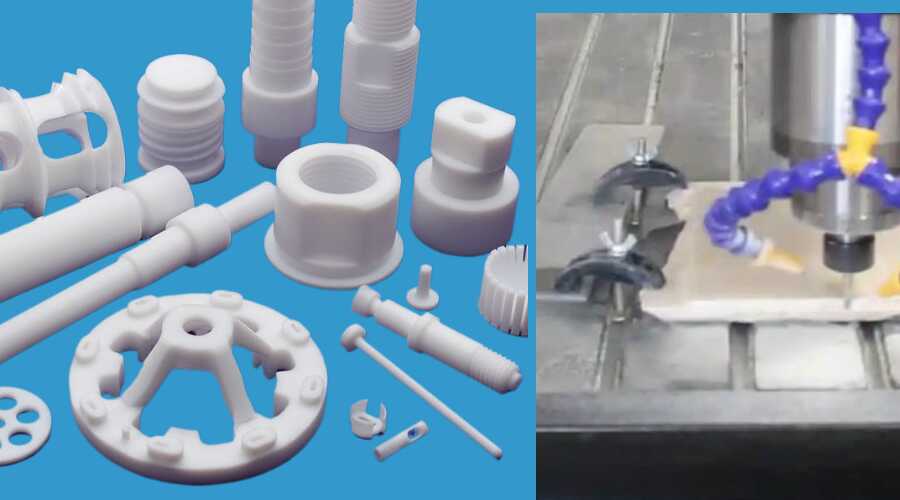How to set the parameters of cnc machining ceramic parts
CNC machining ceramic parameters need to be determined according to the task and material, including cutting speed, feed speed, cutting depth and tool type. Ceramic processing should be handled with care to prevent cracking.

Cnc machining ceramic parameters how to set?
The parameters of CNC machining ceramics should be determined according to the specific processing task and ceramic material. Here are some common parameters:
1. Cutting speed: The hardness of ceramic materials is higher, and a slower cutting speed is required. The general range is between 50-200 m/min.
2. Feed speed: The choice of feed speed should be determined according to the diameter and material of the cutting tool, usually between 10-100 meters per minute.
3. Cutting depth: Due to the hardness and brittleness of ceramic materials, it is necessary to use a shallow cutting depth, generally 0.1-0.3 mm.
4. Tool type: The hardness and brittleness of ceramic materials require the use of high-hardness tool materials, such as diamond, CBN, etc.
5. Cutting fluid: Ceramic materials are susceptible to the impact of cutting fluid, should choose a low concentration of cutting fluid, such as kerosene, diesel, etc.
It should be noted that the processing of ceramic materials needs to be very careful, because any improper operation may lead to the cracking or edge of ceramic materials. Therefore, in the actual processing, the parameters should be determined according to the specific processing tasks and materials, and appropriate adjustments should be made.
The hardness of ceramics is high, the brittleness of the material is large, and it is easy to collapse and fracture during processing. Usually, ceramic parts are processed using special ceramic engraving machining, which can effectively reduce costs and achieve high precision machining.

Ceramic cnc machining speed feed how to set?
In cnc machining of ceramics, speed and feed are important parameters that affect machining quality. In general, according to the hardness and toughness of the ceramic material, as well as the material and geometry of the tool, the appropriate speed and feed can be roughly determined.
For the processing of ceramic materials, high-speed cutting is usually used to improve processing efficiency. Therefore, the speed is generally high, usually between 10000 and 30000r/min. At the same time, due to the high hardness and toughness of ceramic materials, it is necessary to use tool materials with good strength and toughness, such as diamond, CBN, etc. Therefore, the speed of the tool should also be increased accordingly to ensure cutting efficiency.
The speed of feed should be determined according to the cutting speed of the tool and the hardness of the ceramic material. In general, the feed speed should be relatively low, generally between 10 and 100mm/min. This is because the hardness and toughness of ceramic materials are high, if the feed speed is too fast, it will lead to increased wear of the tool, and even the edge.
It should be noted that the specific speed and feed speed also need to be adjusted according to the specific processing conditions and requirements. At the same time, in order to ensure the processing quality, it is also necessary to select and control the cutting fluid to reduce the wear of the tool and improve the quality of the machined surface.
How does cnc process ceramics?
CNC machining of ceramics requires the use of special tools and machining parameters. Ceramic is a hard and brittle material, so a tool with high hardness and high heat resistance is needed. At the same time, the processing of ceramics is more difficult, requiring the use of slow cutting and fine grinding technology.
Before CNC machining ceramics, it is necessary to fix the ceramic material to the machine tool and use special fixtures and tools. Then, according to the shape and requirements of the ceramic material, a reasonable cutting path and processing parameters are worked out.

In the process of processing, it is necessary to always pay attention to the wear and temperature changes of the tool, and adjust it in time. At the same time, the ceramic material also needs to be finely polished and polished to achieve the desired effect.
In short, CNC machining ceramics requires the use of special tools and processing parameters, and requires fine operation and adjustment. Only experienced technicians can complete high quality CNC machining ceramics.
How about processing alumina ceramics?
CNC machining alumina ceramics is a kind of high hardness material, and its processing accuracy and surface quality have an important impact on the performance and service life of the product. Alumina ceramics have the advantages of high strength, high hardness, corrosion resistance, wear resistance, etc., so it is widely used in aerospace, automotive, chemical industry and other fields.
CNC processing of alumina ceramics requires the use of high-precision processing equipment and special tools, while the need to strictly control the temperature, humidity and other environmental factors in the processing process to ensure processing accuracy and surface quality. It is also necessary to pay attention to avoid excessive residue and debris during processing, so as not to affect the quality and performance of the product.